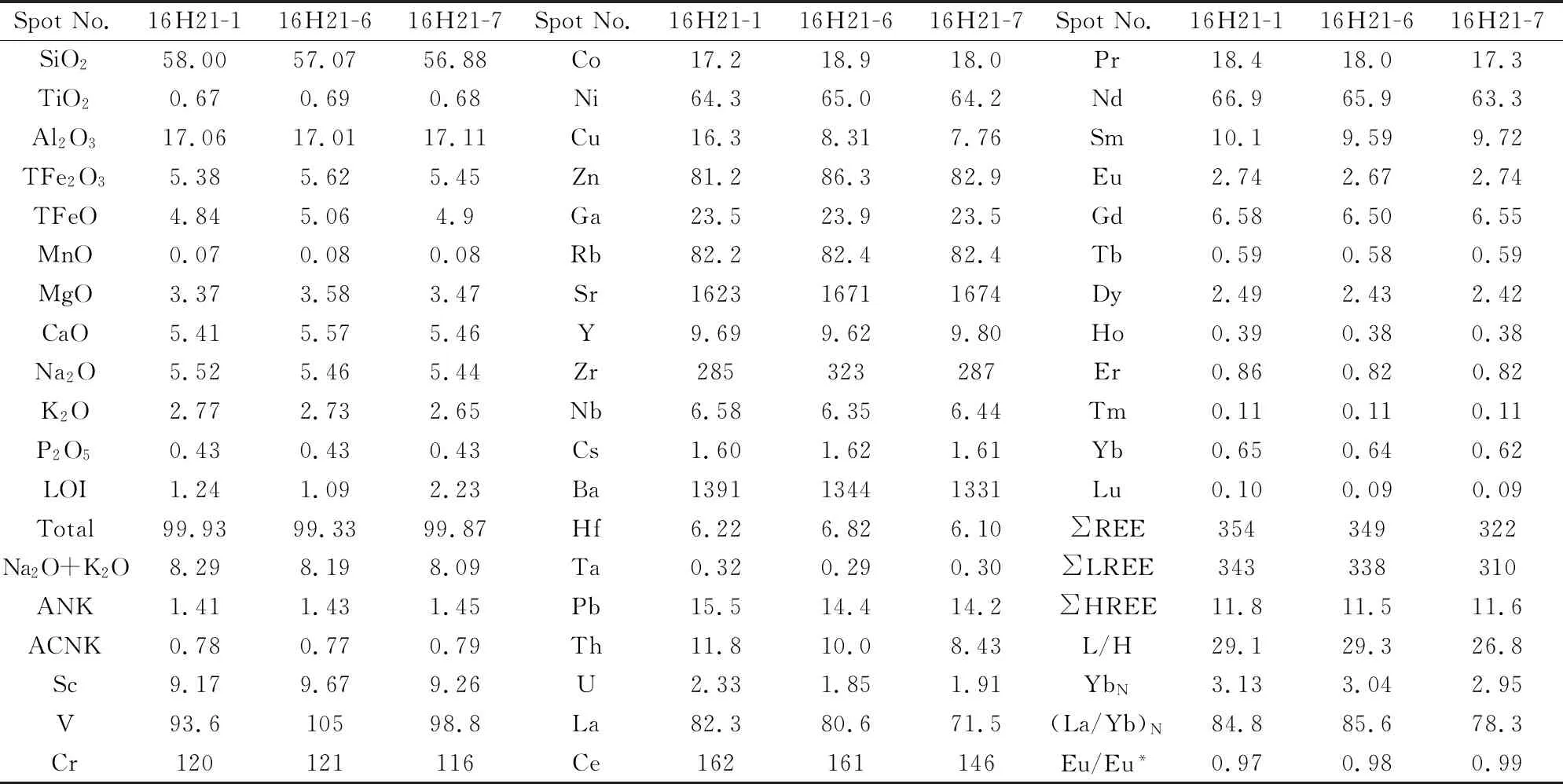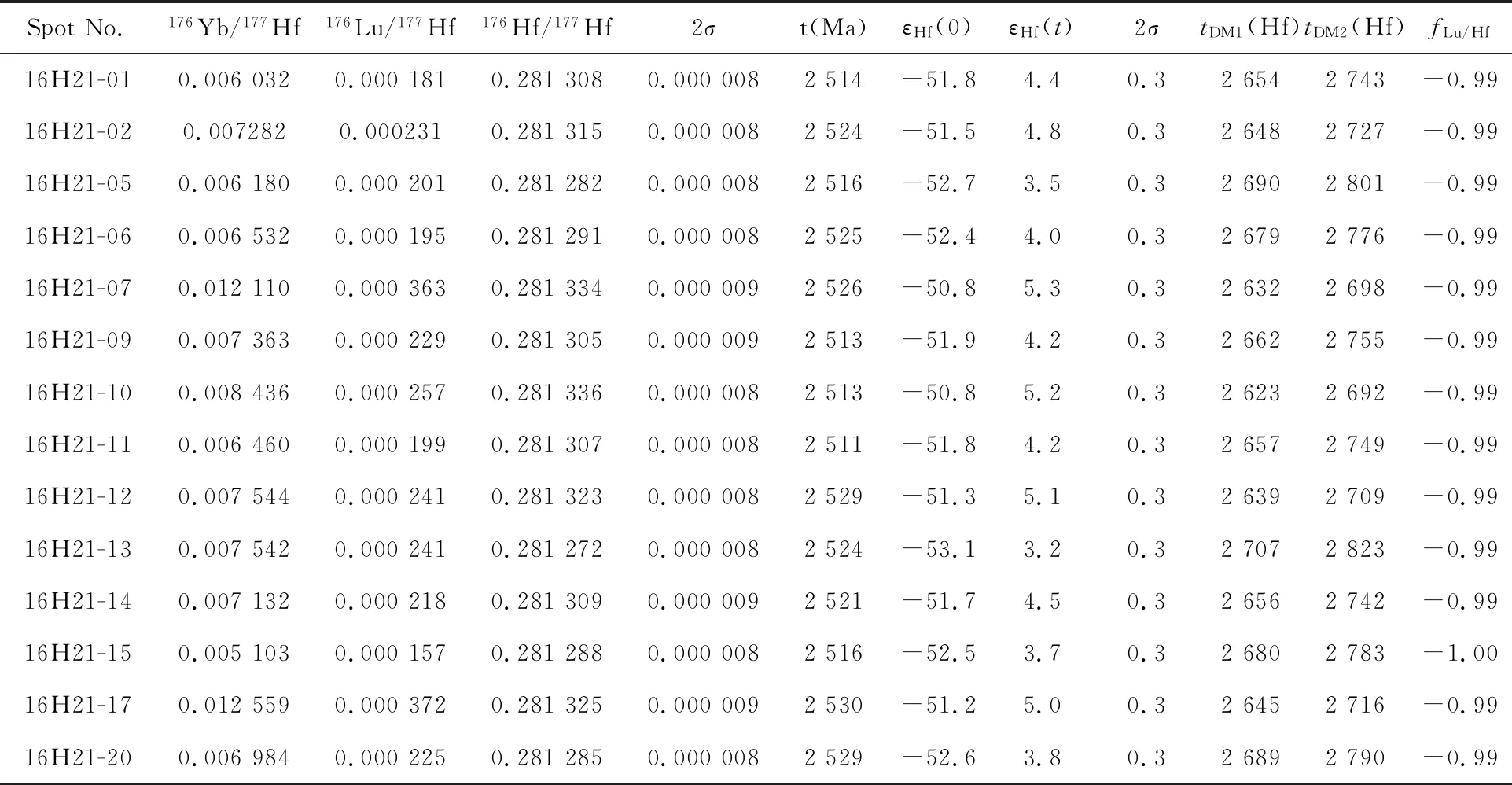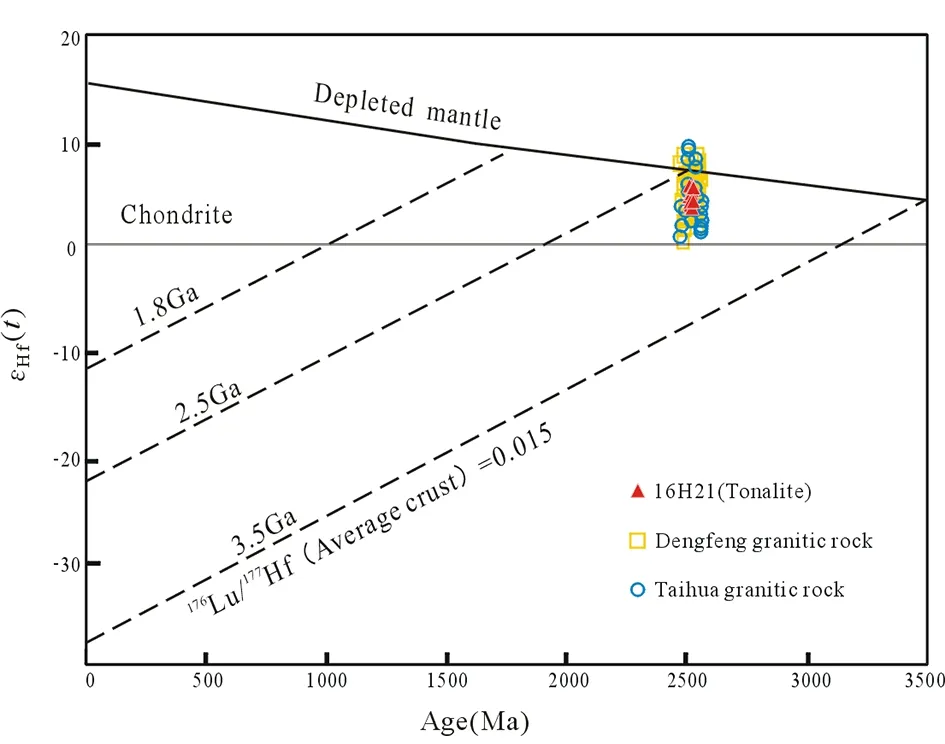U-Pb-Hf isotopes of Neoarchean Shuimowan tonalites in southern margin of North China Craton: constraints on petrogenesis
2020-09-23HAOLeranYANGHaotianandYANGDonghong
HAO Leran, YANG Haotian and YANG Donghong
1. College of Earth Sciences, Jilin University, Changchun 130061, China;2. International Center for Geoscience Research and Education in Northeast Asia, Jilin University, Changchun 130026, China
Abstract: This study presents zircon LA-ICP-MS U-Pb geochronology, trace elements characteristics, whole rock geochemistry composition and zircon Hf isotopic data of Shuimowan tonalites in Dengfeng City. The results show that zircons from Shuimowan tonalites have oscillatory growth zoning, relatively high Th/U ratios (0.8--1.7) and upturned zircon rare earth elements (REE), indicating that they are magmatic origin. Shuimowan tonalites yield a weighted mean 207Pb/206Pb age of 2 522 ± 9 Ma, indicating they were formed in the latest Neoarchean. The tonalites are characterized by relatively low SiO2 contents, high MgO and Na2O contents, high REE (∑REE = 322×10-6-354×10-6), obvious fractionation of REE, enrichment in LREE and feeble negative Eu anomaly (Eu/Eu* = 0.97--0.99). The samples are also enriched in large ion lithophile elements and depleted in high field strength elements, with negative Nb, Ta, P and Ti anomalies. The εHf(t) values of zircon grains from Shuimowan tonalites range between 3.5 and 5.3. Combined with regional tectonic evolution, it is suggested that Shuimowan tonalites were derived from partial melting of mantle peridotite metasomatized by the slab-derived felsic melt and formed in the arc magma tectonic setting related to plate subduction. Research on the Neoarchean Shuimowan tonalites provides a constraint for the study of the Pre-Cambrian tectonic evolution in the southern margin of North China Craton.
Keywords: tonalite; Neoarchean; petrogenesis; Hf isotope; North China Craton
0 Introduction
North China Craton (NCC) is one of the oldest cratonic blocks in the world, mainly consists of Archean to Paleoproterozoic basement overlain by Mesoproterozoic to Cenozoic cover, which then collided with other blocks to form a coherent craton during the Lyuliang Orogeny at ~1.8 Ga. However, the mechanism and timing of aggregation of these micro-continent blocks to form the NCC is controversial. Some scholars believed several micro-continent blocks form preliminary craton at ~2.5 Ga through arc-continent or continent-continent collisions (Zhai & Santosh, 2011). Zhao and Zhai (2013) proposed that collision of the eastern and western blocks along the Trans-North China Orogen (TNCO) at ~1.85 Ga contributed to the formation of NCC. While, Kusky (2011) postulated that the collision of the eastern and western Blocks happened around 2.5 Ga. Hence, the TNCO serve as an excellent area for the NCC Pre-Cambrian research. Former researches on the TNCO mainly concentrated in the central and northern segments, including Zanhuang, Lyuliang, Fuping, Wutai, Huaian and Chengde areas. The researches on the southern section of TNCO focused on the chronology and geochemical studies of Taihua-, Dengfeng- and Xionger’shan groups (Liuetal., 2009; Diwuetal., 2010, 2014; Huangetal., 2010, 2012), but there is still a big disputation about the Neoarchean magmatism and tectonic setting of the southern margin of NCC.
In this paper, we present in situ zircon U-Pb ages, trace elements characteristics, whole-rock geochemistry data and Hf isotopes in zircons of Shuimo-wan tonalites from Junzhao area in the southern NCC.
Combining with past regional achievements, our results help providing constraints for the origin of Neoarchean magmatism in the southern NCC and corresponding tectonic setting.
1 Geological background and sample description
NCC is bounded by the Central Asia orogenic belt in the north, the Qinling-Dabie-Sulu orogenic belts in the middle, the Yangtze Craton in the south, and mainly composed of the eastern block, the wes-tern block and TNCO (Zhaoetal., 2001, 2005). The TNCO consists of several metamorphic basement terranes, including Taihua, Dengfeng, Zhongtiao, Lyuliang, Zanhuang, Fuping, Wutai, Hengshan, Huai’an, Xuanhua and Chengde complexes (Zhaoetal., 2008). These complexes are mainly composed of Neoarchean to Paleoproterozoic TTG gneisses, meta-supracrustal rocks, post-tectonic granites and mafic dykes. Meta- morphic complex from Dengfeng- and Taihua groups comprises ancient rocks well exposed in the southern part of TNCO, which were ideal for the study of the constrains on the crustal evolution of southern margin of the central NCC. Taihua Group outcrops in the Huashan, Xiong’ershan and Lushan areas from west to east, and the Lushan area is the most typical one. Dengfeng Group occurs in the Songshan and Jishan areas in Dengfeng and Ruzhou (Fig.1). The metamorphic grade of Taihua complex is relatively high, mainly consist of granulite facies, which is usually divided into Upper Taihua and Lower Taihua subgroups according to their structural characteristics and rock types (Diwuetal., 2010; Huangetal., 2012). The Dengfeng complex has a lower metamorphic grade, which mainly composed of hornblende facies to granulite facies and granite-greenstone belt in the lower part, but diopside marble, quartz schist and banded biotite migmatite in the upper part. Its Paleoprotero-zoic basement is the Songshan Group, which is composed of conglomerate at the bottom, quartzite in the lower part quartz schist, basalt and granite in the upper part. Two suites of K-rich granite-granodiorite-monzonite are also developed in the Songshan and Minshan areas, which have intruded into the Archean tonalite, trondhjemite and granodiorite (TTG) gneisses in the lower part of the Dengfeng Group (Guan, 1996).

Fig.1 Geological sketch map of the study area and sampling location

Bi-biotite; Pl-plagioclase; Qtz-quartz; Hbl-hornblende.Fig.2 Field photographs and mineral assemblage of Shuimowan tonalites
Shuimowan complex is located near Shuimowan Village, Junzhao County, Dengfeng City, and consists of tonalite and diorite (Fig.2a). The samples in Shuimowan are grayish-white, medium-coarse grained and subhedral with massive structure. They are dominated by ~45% of plagioclase, ~37% of hornblende, ~10% of biotite and ~8% of quartz with minor accessory minerals (e.g., zircon and apatite) (Fig.2b, c).
2 Analysis methods
Zircon LA-ICP-MS U-Pb ages were measured in the Joint Laboratory of Hong Kong University. Zircon grains were separated using standard electromagnetic separation technology. The selected zircon grains were mounted by epoxy and polished until their cores were exposed, then used to obtain transmissive, reflective and Cathodolumninescence (CL) images. Zircon 91500 was used as an external calibration standard for age calculation, and NIST610 was analyzed twice every 10 samples for calibrating elements (e.g., U, Th and Pb). The age calculations and concordia plots were made using Isoplot (ver 3.0). Whole-rock major elements, trace elements and Hf isotopes of all the samples were simultaneously analyzed at the Wuhan Sample Solution Analytical Technology Co., Ltd., Wuhan, China. Major elements analyses were conducted by XRF on fused glass beads. Trace elements were analyzed on Agilent 7500a inductively coupled plasma mass spectrometry (ICP-MS). Hf isotopes analyses were performed using zircon 91500 and zircon GJ-1 as external calibration, a 55 μm laser diameter was selected during the ablation with a laser pulse frequency of 6 Hz.
3 Analytical results
3.1 LA-ICP-MS zircon U-Pb geochronology
In Fig.3a, the smaller circles indicate spots of LA-ICP-MS U-Pb dating, whereas the larger circles represent locations of Hf isotopic analyses. It is shown that zircon grains in Shuimowan tonalites are mainly oval-shaped with minor columnar-shaped. Th/U ratios are relatively high, ranging from 0.8 to 1.7 (>0.4). These zircon grains are euhedral to subhedral and all with magmatic growth zone developed, indicating that they are all magmatic zircons. Zircon trace elements analyses results are given in Table 1. The zircons from Shuimowan tonalites are enriched in heavy rare earth elements (HREE) and depleted in light rare earth elements (LREE), and characterized by intense positive anomaly of Ce and negative anomaly of Eu (Fig.3b), which shows that they are magmatic zircons.

Fig.3 Typical cathodoluminescence images of zircons (a) and chondrite-normalized REE patterns (b) for Shuimowan tonalites

Table 1 Zircon trace elements (10-6) compositions for Shuimowan tonalites
The zircon U-Pb data obtained during this study are listed in Table 2, with corresponding zircon U-Pb isotope concordia plots and weighted mean age diagram respectively shown in Fig.4a and 4b. The207Pb/206Pb ages range from 2 542 Ma to 2 503 Ma, except for two points that fall below the concordant curve, the rest of the points are on the concordant curve. The weighted mean207Pb/206Pb age of 2 522±9 Ma represents that Shuimowan tonalites were formed in the Neoarchean.

Fig.4 Zircon U-Pb isotope concordia diagram (a) and weighted mean age diagram (b) for Shuimowan tonalites

Table 2 LA-ICP-MS zircon U-Pb dating results for Shuimowan tonalites
3.2 Whole-rock major and trace element geochemistry
The whole-rock major and trace element composition of Shuimowan tonalites is given in Table 3. The tonalites (Sample 16H21) have SiO2from 56.88 wt.% to 58.00 wt.%, MgO from 3.37 wt.% to 3.58 wt.%, Na2O from 5.44 wt.% to 5.52 wt.%, K2O from 2.65 wt.% to 2.77 wt.%, and TiO2from 0.67 wt.% to 0.69 wt.%. In the Ab-An-Or diagram (Fig.5a), samples are all plotted in the trondhjemite field. They have metaluminous characteristics and belong to High-K calc-alkaline series (Fig.5b, c). Granitic rocks in Dengfeng- and Taihua complex show similar characteristics in major elements, which mainly locate in the tonalite and trondhjemite field, cal-calkaline series, metaluminous to weak-peraluminous area (Fig.5).
The chondrite-normalized REE patterns and primitive mantle-normalized trace element spider diagrams are given in Fig.6. Shuimowan tonalites show LREE-enriched and HREE-depleted patterns (ΣLREE/ΣHREE=26.8--29.3) with high (La/Yb)Nratios (78.3--85.6) and slightly positive Eu anomalies (Eu/Eu*= 0.97--0.99) (Fig.6a). Shuimowan tonalities contain higher HREE than the Dengfeng- and Taihua granitic rocks (Fig.6a). On the primitive mantle-normalized trace element diagram (Fig.6b), the tonalites are enriched in large ion lithophile elements (LILE; e.g., Cs, Rb and Ba) and depleted in high field strength elements (HFSE; e.g., Nb, Ta and Ti). Comparing Shuimowan tonalites with the granitic rocks in Dengfeng- and Taihua complex, it indicates that they have similar characteristic of trace element.

(a) Ab-An-Or diagram; (b) SiO2 vs. K2O diagram; (c) A/CNK vs. A/NK diagram.Fig.5 Variability plot of major elements for Shuimowan tonalites (reference data from Diwu et al., 2011; Yu et al., 2013; Zhou et al., 2014; Jia, 2016)

Fig.6 Chondrite-normalized REE patterns (a) and primitive mantel-normalized trace element spider diagrams (b) for Shuimowan tonalites (reference data from Diwu et al., 2011; Yu et al., 2013; Zhou et al., 2014; Jia, 2016)

Table 3 Major (wt%) and trace elements (10-6) compositions for Shuimowan tonalites
3.3 Zircon Hf isotopes
In situ Hf isotopic analysis of zircons of Shuimowan tonalites are shown in Table 4. The predominant magmatic zircons in samples display relatively constant176Hf/177Hf ratios ranging from 0.281 272 to 0.281 369, and yield positiveεHf(t) (3.5--5.3). The one-stage Hf model ages (tDM1)and two-stage Hf model ages (tDM2) vary from 2 707 Ma to 2 623 Ma and 2 823 Ma to 2 692 Ma, respectively, both are higher than the formation age. In the plot ofεHf(t) vs. U-Pb age (Fig.7), zircon grains are plotted in the field between chondrite and depleted mantle evolution lines, which are similar to the Dengfeng- and Taihua granitic rocks.

Table 4 Zircon Hf isotopic data for Shuimowan tonalites

Fig.7 εHf(t) vs. U-Pb age of Shuimowan tonalites (reference data from Diwu et al., 2011; Yu et al., 2013; Zhou et al., 2014; Jia, 2016)
4 Discussion
4.1 Latest Neoarchean magmatism in the southern margin of NCC
The weighted mean207Pb/206Pb age of 2 522±9 Ma represents that Shuimowan tonalites were formed in the Neoarchean. The formation ages of Shuimowan tonalites are consistent with the timing of formations of the Xutai and Lujiagou plutons (2 509--2 399 Ma) (Zhouetal., 2011), protoliths of amphibolite (2 500--2 300 Ma) as well as igneous rocks of Taihua Group in the Wuyang area (2 470--2 158 Ma) (Xuetal., 2009; Lanetal., 2017). Diwuetal. (2011, 2014) proposed that the formation age of Dengfeng Group is the same as granitic rocks in the Dengfeng complex, so the formation age of the Dengfeng complex is constrained as 2 547--2 504 Ma, which is the same as Shuimowan tonalites formation age. However, the Taihua complex recorded two prominent stages of magmatic events (2 850--2 700 Ma and ~2 500 Ma), of which the existence of the latest Neoarchean magmatism indicates that there was one stage of magmatism in the southern margin of the NCC.
4.2 Petrogenesis of Shuimowan tonalites
Shuimowan tonalites have relatively low SiO2(61.85 wt.%--73.38 wt.%), high MgO (3.3 wt.%--3.58 wt.%) and Na2O (7.64 wt.%--10.86 wt.%). Combining with high Cr (116×10-6-121×10-6), Ni (64.3×10-6-65.0×10-6) and positiveεHf(t) (3.5--5.3), it is indicated that the primary magma was affected by mantle peridotite. However, characterized by calc-alkaline series, metaluminous composition, Shuimowan tonalites are enriched in LREE and LILE, depleted in HREE and HFSE and with high (La/Yb)Nratios (78.3--85.6). The tonalites show negative Nb, Ta, P, Ti and positive Pb anomalies indicating arc magma geochemical feature. Therefore, Shuimowan tonalites originated from the interaction process of felsic crust-derived magma and mantle peridotite.
Furthermore, the absence of Eu anomalies (Eu/Eu*= 0.97-0.99) suggests that there is little contribution from the residual plagioclase in the melting source area or a lack of crystal fractionation. The relatively high La/Yb and Sr/Y ratios and low HREE va-lues indicate that garnet is the main residual mineral phase. In addition, the apparent negative anomalies of Nb and Ta in the primitive-mantle normalized trace element patterns suggest that rutile is another residual mineral phase in addition to garnet (Xiongetal., 2005). The negative anomalies of P and Ti also show the possibilities of apatite and ilmenite resided in the source area. In conclusion, Shuimowan tonalites were derived from partial melting of mantle peridotite metasomatized by the slab-derived felsic melt. Garnet, rutile, apatite and ilmenite could be the main residual phases in the source area (Dengetal., 2016).
4.3 Tectonic setting of Shuimowan tonalites
Shuimowan tonalites have high amount of REE, obvious fractionation of light and heavy REE, and feeble anomalies of Eu. They are characterized by LILE-enriched and HSFE-depleted patterns. Combing with the negative anomalies of Nb, Zr, P and Ti, it is implied that they have arc-like geochemical affinities. On the other hand, Shuimowan tonalites belong to metaluminous rock and fall in calc-alkaline series. In the tectonic setting discrimination diagrams (Fig.8), Shuimowan tonalites mainly fall in the field of volcanic-arc granite (VAG). Both evidences support that the samples formed in the arc magma tectonic setting related to plate subduction. The traits are consistent with the subduction-accretion tectonic setting proposed by Dengetal. (2016) based on the chronology and isotope geochemical studies of the TTG gneisses, diorite, granites and mafic dikes in the latest Neoarchean.

(a) Yb vs. Ta diagram; (b) (Ta+Yb) vs. Rb diagram; (c) CaO vs. (TFeO+MgO) diagram; (d) (Y+Nb) vs. Rb diagram (reference data from Diwu et al., 2011; Yu et al., 2013; Zhou et al., 2014; Jia, 2016).Fig.8 Tectonic setting discrimination diagrams for Shuimowan tonalites
In addition, the magmatic activity during 2.57--2.48 Ga recorded episodic continental growth through plate subduction and consequent orogeny in the sou-thern of the NCC, consistent with globally recognized periods of plate accretion (Huangetal., 2013). Moreover, it is also consistent with the tectonic setting of TTG gneisses in the Lushan area formed in ~2.5 Ga (Zhouetal., 2011, 2014). They all indicate that the amalgamation of micro-blocks and cratonization at ca. 2.5 Ga in southern part of NCC could be the results of arc-continent collision and continent-continent collision (Zhai & Santosh, 2011). The subduction of ocean crust at ca. 2.5 Ga associated with dehydration and partial melting process formed felsic melts/fluids which metasomatized the upper mantle wedge and caused the mantle peridotite partial melting. Subsequently Shuimowan tonalites in Junzhao area were generated by the rising and emplacement of magma derived from the reaction of felsic melt and mantle peridotite.
5 Conclusion
(1) The average U-Pb weighted age of magma zircons in Shuimowan tonalites is 2 522±9 Ma, which was formed in the latest Neoarchean.
(2) Shuimowan tonalites have relatively low SiO2contents and high MgO and Na2O contents, and are enriched in LREE and LILE but depleted in HREE and HFSE, with distinct negative anomalies of Nb, Zr, P and Ti. Combining with positiveεHf(t) values (3.5--5.3) and high Cr, Ni contents, it is implied that the tonalites were derived from partial mel-ting of mantle peridotite metasomatized by the slab-derived felsic melt.
(3) Shuimowan tonalites were formed in the subduction-related arc magma tectonic setting.
杂志排行
Global Geology的其它文章
- Controlling factors of sphalerite and galena deposition in Baiyinnuo’er skarn deposit, Inner Mongolia, China
- Method for extracting angle-domain common image gathers in Kirchhoff beam migration
- Spatial pattern analysis of forest landscape in Changbai Mountain
- Influence of wettability of shaly sandstone on rock electricity parameters
- Structure analysis of shale and prediction of shear wave velocity based on petrophysical model and neural network
- Determining water well sites based on electrical structure in Taobei District of Baicheng
